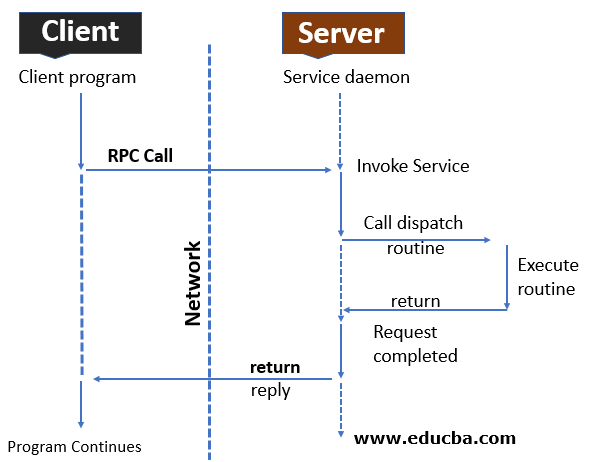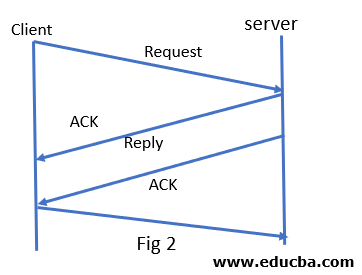
Overview of Remote Procedure Call (RPC)
Remote Procedure Call or RPC is used in distributed computing and this call occurs when a procedure is executed in different address space. This protocol is helpful when the process does not know other computer’s network details and the service are requested in a different computer. This is also called as subroutine call or function call. This has a client server model. The arguments are passed to a remote procedure and the call is sent to the server by the client. RPC can be used in Windows, Apple and UNIX. The authentication of RPC is DES so that the application can be made secure.
What is RPC?
Remote Procedure Call is a protocol for building appropriated frameworks. Essentially, it enables a program on one machine to call a subroutine on another machine without realizing that it is remote.RPC isn’t a vehicle convention rather, it is a strategy for utilizing existing interchanges includes in a straightforward manner.
This straightforwardness is one of the incredible qualities of RPC as an instrument. Since the application programming doesn’t contain any correspondence code, it is autonomous of
- The specific correspondences equipment and conventions utilized
- The working framework utilized
- The calling arrangement expected to utilize the fundamental correspondences programming.
How does RPC Work?
Remote methodology call (RPC), as its name infers, is a component that empowers the software engineer to call a system remotely be it an alternate machine or another procedure by making a nearby, customary, strategy call.
This methodology permits to display a correspondence as a clear capacity calls while concealing the insights regarding the real system. In the long run, it’s a reflection, an idea of system communication.
RPC can utilize various conventions to accomplish it. For instance, HTTP. Along these lines, when RPC is made, the system identifier and parameters serialized into demand message sent to the remote procedure which serves the call. On the remote procedure, the message got deserialized back, the procedure run, and the outcomes returned along these lines. Popular Course in this categoryAll in One Software Development Bundle (600+ Courses, 50+ projects)600+ Online Courses | 3000+ Hours | Verifiable Certificates | Lifetime Access
4.6 (3,144 ratings)Course Price
₹8999 ₹125000
View Course
Related CoursesWindows 10 Training (4 Courses, 4+ Projects)JWS Java Web Services Training (4 Courses, 11 Projects)Java Training (40 Courses, 29 Projects, 4 Quizzes)
How do we Inspect a Graph Model Underneath?
The inspection of graph model underneath is as follows:

- Client machine making an RPC call to a server machine that enrolled to serve this particular call.
- System parameters moved over the system to the applicable server machine.
- Server machine executes the system.
- At the point when the system completes and results are created, they are moved back to the calling condition.
- The execution on the customer machine continues as though coming back from an ordinary (nearby) technique call.
Why do we use RPC?
- RPC is one meaning of how to send organized information as a call to the server and get organized information as a reaction back. We could utilize any of a wide assortment of conventions with a similar essential objective, like SOAP or WCF.
- As we know RPC (remote method call) is a method for demonstrating the correspondence between two applications as clear capacity calls. Since the applications may even be on various machines, an RPC system typically characterizes a network protocol, some arrangement for trading messages, a convenient method for serializing and deserializing information and explicit programming language support (like code generators).
- All things considered, there are various RPC advances, so it is difficult to state what we are referring to. Be that as it may, as a rule, it is a layer over system transports (like UDP and TCP) to Marshall parameters and call results. We need it to convey in an organized manner with administrations. Some generally utilized applications and framework administrations utilize understood RPC systems (like Windows DCOM, NFS mount convention, Kerberos, SAP RFC).
Advantages of RPC
- Procedure arranged and string focused models bolstered by RPC.
- With RPC code re-composing/re-creating exertion is limited.
- RPC regularly overlooks a significant number of the convention layers to improve execution. Indeed, even a little presentation improvement is significant in light of the fact that a program may summon RPCs frequently.
- Server independent.
- The advancement of appropriated frameworks is basic since it utilizes direct semantics and simpler.
- RPC gives abstraction it means the message-passing nature of system correspondence is avoided by the client.
- With RPC code re-composing/re-creating exertion is limited.
The principal objective of RPC is to conceal the presence of the system from a program. Thus, RPC doesn’t exactly fit into the OSI model.
The message-passing nature of system correspondence is avoided by the client. The client doesn’t initially open an association, peruse and compose information, and afterward close the association. In reality, a customer regularly doesn’t realize they are utilizing the system!
Conquering Network Limitations
RPC conventions frequently play out extra capacities to manage the way that networks are not perfect stations. Two such capacities are:
- Give dependable message conveyance
- Supports enormous message measures through fracture and reassembly.
An RPC convention may “characterize this issue away” by deciding to run over a dependable convention like TCP, however, as a rule, the RCP convention executes its very own solid message conveyance layer over an untrustworthy substrate (e.g., UDP/IP). Such an RPC convention would almost certainly execute unwavering quality utilizing affirmations and breaks, likewise to TCP.
The fundamental algorithm is clear, as represented by the course of events given in Fig 2. The customer sends a solicitation message and the server recognizes it. At that point, after executing the procedure, the server sends an answer message and the customer recognizes the answer.

Conclusion
RPCs are a type of between process correspondence (IPC), in that various procedures have diverse location spaces: if on a similar host machine, they have particular virtual location spaces, despite the fact that the physical location space is the equivalent; while on the off chance that they are on various hosts, the physical location space is unique. Remote Procedure Call is a strategy that is getting progressively significant in material science tests, with the abundance of circulated handling power. Involvement with CERN in the course of the most recent three years has exhibited that a similar plan method can be applied in situations as different as inserted eight-piece processors without working frameworks, M68020 processors running with or without ongoing administrators, VAX frameworks and workstations running VMS, and PCs.
Recommended Articles
This has been a guide to What is RPC? Here we discuss how does RPC Works? why we use them and the advantages of RPC. You may also have a look at the following articles to learn more –
